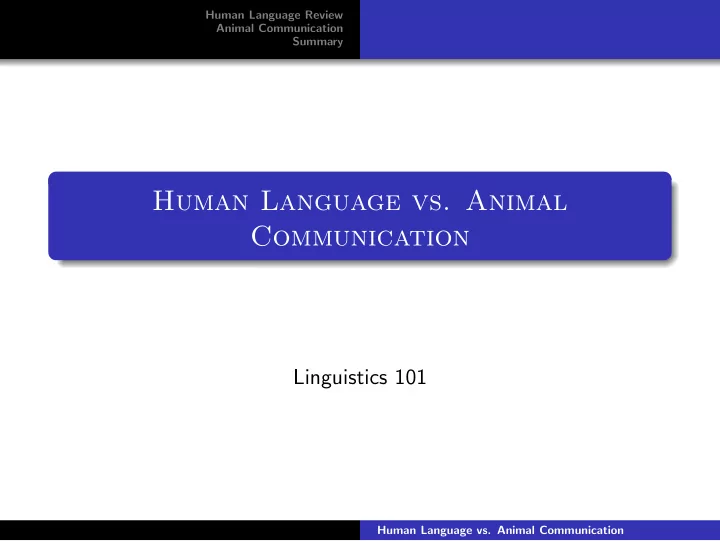

Human Language Review Animal Communication Summary Human Language vs. Animal Communication Linguistics 101 Human Language vs. Animal Communication
Human Language Review Animal Communication Summary Outline 1 Human Language Review 2 Animal Communication Honeybees Birds Dogs Non-human Primates 3 Summary Human Language vs. Animal Communication
Human Language Review Animal Communication Summary What Is Human Language? Human language consists of a lexicon and a grammar. Design features of human language: Semanticity Pragmatic function Interchangeability Cultural transmission Arbitrariness Discreteness Displacement Productivity Human Language vs. Animal Communication
Honeybees Human Language Review Birds Animal Communication Dogs Summary Non-human Primates Animal Language? Animals can convey various message to each other, such as: feelings (anger, fear) warnings desire/willingness to mate location of food sources Nonetheless, animals lack anything like human language. Question Which aspects/features of human language are missing in animal communication systems? Human Language vs. Animal Communication
Honeybees Human Language Review Birds Animal Communication Dogs Summary Non-human Primates Honeybee Dance Dance to communicate Dance communicates direction and distance to food source Not entirely arbitrary Question How does the dance indicate direction? How does the dance indicate distance? Honeybee Dance Video http://www.youtube.com/watch?v=bFDGPgXtK-U Human Language vs. Animal Communication
Honeybees Human Language Review Birds Animal Communication Dogs Summary Non-human Primates Birdcalls and Bird Songs Birdcalls (one note) messages about surroudings Bird songs (patterns of notes) territorial purposes mating purposes European Robin’s song complex despite complexity, only high-low alteranation is important indicate degree of willingness to defend territory Human Language vs. Animal Communication
Honeybees Human Language Review Birds Animal Communication Dogs Summary Non-human Primates Birds and Human Language Some birds can imitate human speech. Is this language? cannot learn structure cannot create novel utterances imitate sounds regardless of source Lyre Bird http://www.youtube.com/watch?v=VjE0Kdfos4Y Human Language vs. Animal Communication
Honeybees Human Language Review Birds Animal Communication Dogs Summary Non-human Primates Dogs and Human Language Dogs learn to understand certain commands. Most famous dog (concerning language) is Chaser learned more than 1,000 nouns (for toys) performs basic actions in response to commands consisting of a verb (paw, nose, take) and a noun demonstrated power of deduction when asked to find novel object Chaser Video http://www.youtube.com/watch?v=_6479QAJuz8 , longer video at http://video.pbs.org/video/1778564622 (starting at 10:42) Human Language vs. Animal Communication
Honeybees Human Language Review Birds Animal Communication Dogs Summary Non-human Primates Primate Communication In their native systems: calls are species-dependent lack displacement lack productivity Human Language vs. Animal Communication
Honeybees Human Language Review Birds Animal Communication Dogs Summary Non-human Primates Primates and Human Language Primates are physically unable to produce human speech sounds. Primates are known to use communicative gestures in the wild. For these reasons, modern studies with non-human primates rely on sign language or other visual communication systems. Human Language vs. Animal Communication
Honeybees Human Language Review Birds Animal Communication Dogs Summary Non-human Primates Primates and Human Language Studies: Washoe and Koko learned 100-200 signs claims of novel utterances (generally 2-word) Study: Nim Chimpsky rarely initiated conversation signs often simply repetition of trainer no evidence of grammar longest utterance: ‘give orange me give eat orange me eat orange give me eat orange give me you’ Human Language vs. Animal Communication
Honeybees Human Language Review Birds Animal Communication Dogs Summary Non-human Primates Primates and Human Language Koko Video http://www.youtube.com/watch?v=X67zBy0IQqw Discussion Describe the interaction between Koko and the trainer. Who initiated conversation? How much did Koko ‘talk’? How accurate was Koko? Lana Video http://www.youtube.com/watch?v=hAocz4m88JQ Discussion Why are random symbols used for Lana? How well does Lana ‘speak’? What should we make of Lana’s repitition? Human Language vs. Animal Communication
Honeybees Human Language Review Birds Animal Communication Dogs Summary Non-human Primates Primates and Human Language Some general issues with primate studies... primates need extensive training training focuses on very specific templates trainers sometimes add own interpretation learning of grammar (e.g. syntax) is lacking results are sometimes anecdotal rather than experimental primates do not pass down ability to sign to their young claims that primates have learned or aquired human language are greatly exaggerated Human Language vs. Animal Communication
Human Language Review Animal Communication Summary Summary What can animals do? Some can learn hundreds of signs. Some can associate meaning with sign. Some show understanding of simple, novel combinations. But... Most animals merely exhibit stimulus-response behavior. Ability to learn structure is lacking. Novel utterances are rare. Human Language vs. Animal Communication
Recommend
More recommend